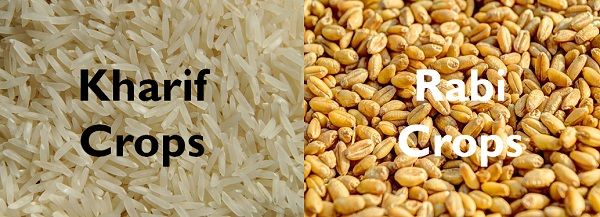 Kharif and Rabi are the two cropping patterns which are adopted in many Asian countries, depending upon the monsoon. The cropping season of Kharif crops starts with the onset of monsoon and ends when the rainy season is over. On the other hand, Rabi crops are grown in winter, i.e. sown when monsoon ends and harvested before the advent of the summer season.
Kharif and Rabi are the two cropping patterns which are adopted in many Asian countries, depending upon the monsoon. The cropping season of Kharif crops starts with the onset of monsoon and ends when the rainy season is over. On the other hand, Rabi crops are grown in winter, i.e. sown when monsoon ends and harvested before the advent of the summer season.
Kharif crops require hot and wet climate whereas cold and dry climate is best suited for Rabi crops. Rainfall plays a significant role in the yield of the two types of crops, in the sense that rain is good for Kharif crops while the same may spoil the yield of Rabi crops.
In general, there are only a few people who are aware of the two agriculture patterns. However, it is important for all to know the difference between kharif and rabi crops, as the prices of food grains and vegetables highly depend on the yield of these two.
Content: Rabi Crops Vs Kharif Crops
Comparison Chart
| Basis for Comparison | Kharif Crops | Rabi Crops |
|---|---|---|
| Meaning | Kharif crops can be described as the crops which are sown with the beginning of the rainy season. | Rabi crops are the crops that are sown after the end of the monsoon, i.e. during the winter season. |
| Major Crops | Rice, maize, cotton, groundnut, jowar, bajra, etc. | Wheat, peas, gram, oilseeds, barley, etc. |
| Requirement | It requires huge amount of water and hot weather to grow. | It requires warm climate for seed germination and cold climate to grow |
| Flowering | Require shorter day length | Require longer day length |
| Sowing month | June - July | October - November |
| Harvesting month | September - October | March - April |
Definition of Kharif Crops
Kharif crops, popularly known as monsoon crops, is defined as the crops grown in Asia in the rainy seasons, i.e. from June to September. These crops are planted with the onset of first rains, due to the south-west monsoon. The timing and quantity of rainwater are the two important factors that decide the output of Kharif crops. The main crops are paddy, maize, jowar, bajra, cotton, groundnut, sugarcane, turmeric, pulses, etc.
In India, the sowing dates may vary according to the reach of monsoon in each state, meaning that, in southern states like Kerala, Tamil Nadu, etc. the crop is usually sown towards the end of the May, after which it advances towards North India. Therefore, the Kharif crops are usually sown in late June in the northern states.
Definition of Rabi Crops
The term ‘Rabi’ is an Arabic word, which means spring. Rabi crops are the crops which are planted at the beginning of winter season and harvested in the spring season, in the South Asian countries, i.e. India, Bangladesh, Pakistan, etc. These are sown with the end of monsoon in the country, usually in late October or early November.
As the cultivation of rabi crops is done in dry season, these require timely irrigation to grow. The main rabi crops are wheat, gram pea, oat, barley, onion, potato, tomato and many seeds such as mustard, sunflower, rapeseed, linseed, cumin, coriander, etc.
Key Differences Between Kharif and Rabi Crops
The difference between kharif and rabi crops can be drawn clearly on the following grounds:
- Kharif crops refer to the crops sown in South Asian countries with the beginning of the rainy season. On the other extreme, Rabi crops imply the crops that are grown when the rainy season is over and the winter season begins.
- Kharif crops need a lot of water and hot weather to grow, whereas rabi crops require a warm weather for the germination of seeds and cold climate to grow.
- At the time of growth, Kharif crops require warm wet weather and shorter length of day for flowering. On the contrary, for growing rabi crops cold and dry weather is required and longer day length for its flowering.
- The sowing months of Kharif crops are June and July. Conversely, rabi crops are usually sown in October and November.
- Kharif crops are harvested in September and October. Unlike, the best time to harvest Rabi crops is in March and April.
Conclusion
Kharif and Rabi crops are primarily used to point out the right time to sow and raise a particular crop. Apart from these two, there is one more type of crop, which is grown in the summer season, i.e. from March to June, known as Zaid crops. These are cultivated for short duration, between Rabi and Kharif season. It includes watermelon, muskmelon, bitter gourd, cucumber, etc.



R.K says
Good
Ashish says
A simple, lucid, and informative explanation of a concept that has befuddled me for close to 15 years now – right from when I came across these terms for the first time in geography class in middle school.
Anurag Pathak says
Good Comparison thanks
Varshith says
Best for any difference answers
Good keep it up “keydifferences”
Hari prakash says
Thanks for the article
Sakina says
Good and amazing article I ever read full learning full knowledge like this site.. *
Kunjalata Nayak says
Best